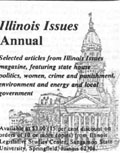* Illinois Economic Growth Study, 78 pp., charts and tables,$15 to members of State Chamber, $25 for nonmembers.

HOW DOES Illinois fare with respect to business climate? Business interests last spring engaged in debate with some state officials over whether industry was leaving the state or, on the contrary, being attracted to Illinois.
Then Business Week came out with a special report. " The Second War Between the States " (May 17) tells how and why business has been moving from the Northeast and the Great Lakes states to the South and Southwest: better climate in the South and Southwest, lower wages, abundant land, more federal spending, lower state and local taxes, lower state welfare costs —factors that attracted people and then industry. It was a disconcerting report.
In mid - July, this was followed by a study commissioned by the Illinois State Chamber of Commerce and written by A. James Heins*, a University of Illinois (Urbana) economist who has published previous studies of Illinois public finance. Heins' purpose was to compare Illinois' economic growth in the post-World War II period with that of other states and "to identify the determinants of economic growth and there-in to foster a healthier economic climate in ... Illinois. "
General findings
Hems' general findings, based on performance in 28 states during the period 1947-74, are these:
"(1) High corporate income taxes were associated with slower economic growth;
"(2) high welfare spending and slow growth were related;
"(3) higher education spending meant greater growth;
"(4) high average hourly pay meant lower rates of growth;
"(5) work stoppages adversely affect growth."
Heins adds a caution to his findings: " Statistical analysis can only show strength of relationship; it cannot prove cause and effect.... Any conclusion about cause and effect within those relationships are a matter of interpretation and are frequently subject to dispute. " What he is saying, I think, is that higher education spending, for example, does not necessarily result in economic growth (although we might like to think so); it could be that a state which experiences economic growth has more money to spend on public education and does so. Similarly with theother relationships, one must bear in mind that either may be the cause of the other — or that both stem from a common cause.
The Illinois picture
When Heins puts Illinois under the microscope, he finds that Illinois' actual growth exceeded expected growth in the1960-67 period but after 1967 fell below the expected growth rate. The rate of state spending and taxes also increased in 1967; " the rate of growth in Illinois taxes and spending was less than for then ation as a whole prior to 1967, but exceeded national growth after 1967."Spending on welfare and education in particular forged ahead of the national rate. The increases in taxes and spending, he emphasized, predate adoption of the personal and corporate income taxes in 1969. The income tax, he says, " was the result of the spending increase, not the caused."
He also emphasizes that Illinois is not a "high tax state." "The point is that until 1967, Illinois was a 'low tax state. 'After 1967 it became an 'average tax state.' On the way from low to average it had to experience higher than average increases in taxes. And, Illinois' economic growth pattern seems to have suffered. " His remedy:
"Slow the rate of growth of government, and in particular, gain better control over the welfare system. Beyond that, there must be some restraint placed on increasing the rate of business taxation."
But his outlook is encouraging. Education and welfare, he says, benefit those in ages zero to 20 and over 64. This" high support group " increased from 40per cent of the population in Illinois in1950 to 49 per cent in 1970. Now it is leveling off and " will again constitute about 40 per cent of the population if present trends continue " by 2000. If the line can be held on taxes and spending, he believes that " reduced demands from a declining support sector will afford us the luxury of a class education system, reasonable welfare programs, and an accoutrement or two without increasing taxes. In my moments of wildest imagination, I even perceive a tax relief program down the pike. "
|
A possibility that holds a major promise for Illinois' economic future, is one familiar to those who have read the articles in this magazine dealing with coal and energy: finding an environmentally acceptable way to clean up this state's coal resources. (Watch for up-coming article on Illinois' coal gassification projects by Sue Kennedy.) Given such a technological break through, Heins estimates the creation of 20,000 to100,000 new jobs is possible, depending on the rate of investment in natural resources. Attracting investment to Illinois is what this report is all about. / W.L.D.˛
* Illinois Economic Growth Study, 78 pp., charts and tables,$15 to members of State Chamber, $25 for nonmembers. |

|